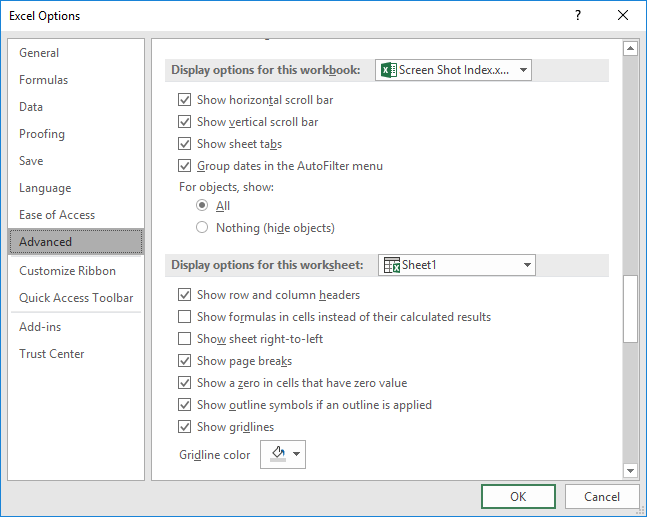Please Note: This article is written for users of the following Microsoft Excel versions: 2007, 2010, 2013, 2016, 2019, 2021, 2024, and Excel in Microsoft 365. If you are using an earlier version (Excel 2003 or earlier), this tip may not work for you. For a version of this tip written specifically for earlier versions of Excel, click here: Controlling Display of Page Breaks.
Written by Allen Wyatt (last updated February 8, 2025)
This tip applies to Excel 2007, 2010, 2013, 2016, 2019, 2021, 2024, and Excel in Microsoft 365
There are two types of page breaks that can appear in an Excel worksheet: manual or automatic. You insert page breaks manually by using the Breaks tool on the Page Layout tab of the ribbon. Automatic page breaks are those that are calculated by Excel based on various settings, such as page size, margins, cell size, and the like.
Excel allows you to control whether page breaks are displayed on-screen (as dashed lines) by following these steps:

Figure 1. The Advanced options of the Excel Options dialog box.
ExcelTips is your source for cost-effective Microsoft Excel training. This tip (8847) applies to Microsoft Excel 2007, 2010, 2013, 2016, 2019, 2021, 2024, and Excel in Microsoft 365. You can find a version of this tip for the older menu interface of Excel here: Controlling Display of Page Breaks.

Best-Selling VBA Tutorial for Beginners Take your Excel knowledge to the next level. With a little background in VBA programming, you can go well beyond basic spreadsheets and functions. Use macros to reduce errors, save time, and integrate with other Microsoft applications. Fully updated for the latest version of Office 365. Check out Microsoft 365 Excel VBA Programming For Dummies today!
Enter a value into a cell and "poof!" it is automatically divided by 100. What's going on, and how can you fix it so that ...
Discover MoreGridlines are very helpful in seeing where cells are located on the screen. You are not limited to black gridlines; ...
Discover MoreExcel can recalculate your worksheets either automatically or manually. The default is to calculate them automatically, ...
Discover MoreFREE SERVICE: Get tips like this every week in ExcelTips, a free productivity newsletter. Enter your address and click "Subscribe."
2025-02-08 11:29:11
J. Woolley
You can see page breaks by switching the View from Normal to Page Layout or Page Break Preview. The three views are selected in the status bar at bottom-right of Excel's window or by use of the Ribbon. If you choose the Ribbon, pick
View > Page Layout (Alt+W+P) or View > Page Break Preview (Alt+W+I).
My Excel Toolbox includes the TogglePageBreaks macro to enable or disable display of page breaks on the active worksheet in Normal view. The keyboard shortcut is Ctrl+T P B. Undo (Ctrl+Z) is supported. Here is an abbreviated version:
Sub TogglePageBreaks()
Const myName As String = "TogglePageBreaks"
If TypeName(ActiveSheet) <> "Worksheet" Then Beep: Exit Sub
With ActiveSheet
.DisplayPageBreaks = (Not .DisplayPageBreaks)
End With
Application.OnUndo myName, (ThisWorkbook.Name + "!" + myName)
End Sub
See https://sites.google.com/view/MyExcelToolbox
Got a version of Excel that uses the ribbon interface (Excel 2007 or later)? This site is for you! If you use an earlier version of Excel, visit our ExcelTips site focusing on the menu interface.
FREE SERVICE: Get tips like this every week in ExcelTips, a free productivity newsletter. Enter your address and click "Subscribe."
Copyright © 2026 Sharon Parq Associates, Inc.
Comments